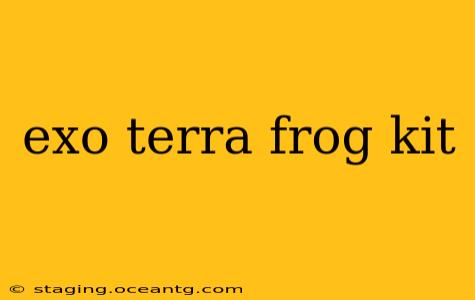The Exo Terra terrarium kit is a popular choice among reptile and amphibian keepers, offering a pre-assembled habitat designed for ease of setup and maintenance. This comprehensive guide will delve into the Exo Terra frog kit, exploring its features, benefits, suitability for various frog species, and frequently asked questions. Whether you're a seasoned herpetologist or a new amphibian enthusiast, this article will provide valuable insights to help you create a thriving environment for your frog.
What is Included in an Exo Terra Frog Kit?
The specific contents of an Exo Terra frog kit can vary depending on the size and model. However, most kits include the following essential components:
- Glass Terrarium: A sturdy glass enclosure providing excellent visibility and ventilation. The size is crucial, ensuring ample space for your frog to thrive and move comfortably. Overcrowding can lead to stress and health problems.
- Background: A pre-formed background, often featuring realistic-looking textures and colors, to provide visual enrichment and climbing opportunities for arboreal frog species.
- Screen Top: A mesh top for ventilation, preventing overheating while still providing a secure enclosure. This is vital for maintaining appropriate humidity levels.
- Substrate: While the type of substrate varies, it's usually a base layer for drainage and moisture retention. Choosing the correct substrate is crucial for maintaining a healthy environment.
- Decorative Elements: These can include artificial plants, rocks, and branches to create a stimulating and naturalistic environment.
It's essential to note that some kits may include additional accessories, such as lighting or heating equipment, but these are often sold separately and must be carefully chosen based on your frog species' specific needs.
What Size Exo Terra Kit Do I Need?
Choosing the right size Exo Terra kit is paramount to your frog's well-being. A terrarium that is too small will stress your frog, while one that is too large can make it challenging to maintain appropriate humidity and temperature levels. The size you need depends entirely on the adult size of your frog species. Research the adult size of your chosen frog and select a terrarium that allows ample space for movement, basking, and hiding. Always err on the side of slightly larger rather than too small.
What Kind of Frogs are Suitable for an Exo Terra Kit?
Exo Terra kits are versatile and can accommodate various frog species, but the specific requirements vary considerably. Generally, arboreal frogs (those that spend most of their time in trees and vegetation) benefit from taller enclosures with ample climbing opportunities, while terrestrial frogs (those that live primarily on the ground) may need a wider, lower setup. Before purchasing any frog and kit, thoroughly research the species' specific needs regarding humidity, temperature, lighting, and substrate. Some examples of frogs suitable for Exo Terra setups (depending on kit size and modifications) include:
- Tree Frogs (various species): Many tree frogs thrive in a well-designed Exo Terra kit.
- Poison Dart Frogs (various species): These require specific environmental parameters and a well-maintained setup.
- Pacman Frogs: These terrestrial frogs need a suitably large, low-profile enclosure.
Important Note: Never select a frog based solely on the availability of a suitable enclosure. Always research the frog's needs first.
How Do I Set Up My Exo Terra Frog Kit?
Setting up your Exo Terra frog kit involves several key steps:
- Research Your Frog's Needs: This is the most crucial step. Determine the specific temperature, humidity, lighting, and substrate requirements for your chosen frog species.
- Choose the Right Substrate: Select a substrate that retains moisture but also allows for drainage to prevent root rot. Common choices include coconut fiber, sphagnum moss, and leaf litter.
- Add Hiding Places: Frogs need secure places to rest and feel safe. Include rocks, caves, cork bark, or other hiding spots.
- Install Lighting and Heating: Use appropriate lighting and heating sources to maintain the correct temperature gradient. This may involve a heat lamp, heat mat, or a combination of both. Avoid overheating.
- Maintain Humidity: Monitor and maintain the appropriate humidity levels through misting, a humidifier, or by using a water feature.
- Add Plants and Decorations: Select non-toxic plants and decorations that enhance the aesthetic appeal and provide climbing opportunities.
What are the Best Accessories for an Exo Terra Frog Kit?
While the basic Exo Terra kit provides a foundation, additional accessories can enhance the frog's habitat:
- Appropriate Lighting: This depends on the frog species and might include UVB lighting (for some species) and heat lamps.
- Humidity Gauge and Thermometer: Essential for monitoring and maintaining optimal environmental conditions.
- Water Feature: A shallow water dish or a waterfall can increase humidity and provide drinking water.
- Misting System: This helps to regulate humidity and provide water for the frog.
- Background: A realistic background adds visual stimulation and climbing opportunities.
How Do I Clean My Exo Terra Frog Kit?
Regular cleaning is essential to prevent the build-up of waste and harmful bacteria. Spot clean the enclosure regularly, removing waste and uneaten food. Perform a thorough cleaning of the entire enclosure every few weeks or as needed, disinfecting surfaces with a reptile-safe disinfectant. Always remove your frog before cleaning.
By following this guide and conducting thorough research on your specific frog species, you can create a thriving and enriching environment within your Exo Terra frog kit, ensuring your amphibian companion enjoys a long and healthy life. Remember, responsible pet ownership requires dedication and attention to detail.
